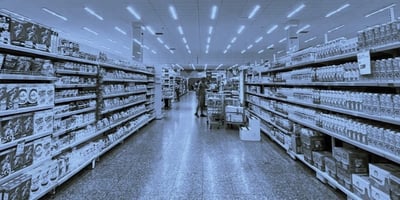What does a sustainable supply chain look like?
To answer this question, we spoke to Jeffrey Whitford, Head of Sustainability, Social Business Innovation, and Life Science Branding at MilliporeSigma. Jeffrey joined me as a guest in the second webinar of our thriving sustainably webinar series to discuss sustainability in the supply chain.
Watch the full conversation on-demand.
Here are some of the key learnings from our discussion:
The vast majority of sustainability impact is in the supply chain
Research from a McKinsey analysis and report, published in 2022, looks at the impacts as well as a breakdown of greenhouse gas emissions in consumer goods companies. 90% of natural capital impacts are in supply chains. And 80% of greenhouse gas emissions are in supply chains (scope 3 emissions). Yet only 25% of companies engage their suppliers in embedded emissions.
A study by EY across 525 executives highlighted the number one motivator for improving supply chain sustainability was cost savings, followed by regulatory compliance, and then pressure from partners and supplies. It was interesting that after those three was the potential for improved revenue growth. These four business reasons stood above pressure from customers and from the workforce. Jeffrey mentioned that he takes multiple calls every day from customer who are holding MS accountable.
“In a typical week I will do multiple customer calls in a day, where we're talking about what are we doing, what's our plan for reduction, how are we giving them a broader selection of products that reduce environmental impact? What's the data behind it? And more importantly, what's the data? Where's the transparency? And then how are you addressing all of these myriad of other things?”
Industry leaders are moving the needle
BMW and Unilever are two examples we shared in the webinar of companies who are not only making public statements but are also establishing contracts with their suppliers and defining what sustainability in their supply chain looks like. There is a long way between making statements and achieving results, and it can be hard to determine from the outside if there is real accountability or simply just grand statements being made, but some companies are actively affecting change.
“What's important is that you've got companies who have a significant presence giving market signals. And that's really the important piece, is more consistency from organizations about expectations for the supply chain help start moving the needle, right?”
A third great example of a company who is seriously and actively addressing sustainability is MilliporeSigma (along with its parent company Merck Group). It was a tremendous pleasure to have Jeffrey join us to learn firsthand what MilliporeSigma are doing and to hear his advice.
I agree. The actions that leaders such as MilliporeSigma, BMW and Unilever are undertaking are starting to move the needle.
“For certain parts of the supply chain, you may not be a main purchaser with that supplier. And so your voice may not matter as much, but there could be someone else who is a significant customer because they are a significant customer and they start doing this. That enables a domino effect that then makes it possible for everyone who is a customer of that supplier.”
That said, results are a different story than commitments. As Jeffrey pointed out, it is one thing to put rules in place for all of our suppliers, but what happens if you have a single source supplier who does not meet your requirements? What happens if a future global event occurs that requires the supply chain sustainability commitment to be set aside in order for the company to survive? There are still hard issues to be resolved.
Progressive learning: Start simple, start somewhere, get complex later
The challenges in addressing supply chain sustainability can be significant, five top reasons being:
- Lack of visibility
- Cost
- Difficulty in monitoring
- Lack of frameworks
- Lack of expertise
It is very easy to get overwhelmed. Simply cataloging a company’s emissions can be a daunting task, especially when the supply chain is considered. And as your get to smaller companies in the supply chain, there are less resources available in those companies to address sustainability.
“You can get into paralysis analysis with this one, because you look at it and you're like, it's too much. I don't know if I want to go anywhere near it. We have to take the best information that we've got and understand are we directionally, correct? And then if we're directionally correct, let's go, let's commit and start moving. And I have been a huge fan, and I heard this term recently and I was like that is it, of this progressive learning.”
MilliporeSigma are creating an actionable toolkit for its supply chain, so it can take the lessons they have learned and make them executable for companies in its supply chain who may not have the same capability to address and attack sustainability. Jeffrey called this a playbook.
Addressing the sustainability of your suppliers is very hard when you have 300,000 products as MilliporeSigma does. You can’t tackle it all at once. You have to break it down. Jeffrey’s advice is to categorize into big groups, get to the most important things, and start working your way through the rest of the pyramid.
“[Sustainability] is also part of business, and that means there is a competitive function here where I am going to put my creativity, my business savvy to work, to figure out if there are ways that I can propel our organization forward to bring new solutions to the marketplace.”
Sustainability and transparency
Be data-driven and transparent. Be honest, including when you fail. MilliporeSigma looks at numbers and uses this approach as a competitive advantage.
“For me, that customer angle is the realization of, this is a competitive advantage. This is an opportunity for us to differentiate in the marketplace. We are committed to being data-driven and transparent about the progress, also about the struggles.”
Jeffrey articulates how MilliporeSigma has improved things with granular data to back it up, and that is more important than saying a certain process is now green. The data and transparency builds trust with his customers.
"Data and transparency become really key. If someone is going to say, why are you considering that a greener alternative? Notice, I said greener not green. Why are you considering that a greener alternative? I want to be able to specifically show them quantitative data about the specific reductions from one thing to the next.”
Thriving sustainably
Answering the question “what does a sustainable supply chain look like?” is not easy. Today, it looks like a top-down driven approach taken by relatively few, early leaders, consisting of commitments (sometimes contractual) to make improvements. And it occasionally looks like companies working together within and across supply chains to make improvements. It is not occurring at scale yet and is hard to create and measure. That said, sustainability in the supply chain needs to start somewhere now, with whatever limited capability and impact we can have, rather than waiting until it is easy to do more thoroughly. Leading companies have already started.
How can business leaders address sustainability in a profitable while still creating business value?
With this Sopheon guide, you’ll learn why it’s important to prioritize sustainability in innovation and new product development, and what questions to ask to help reduce your environmental impact and identify areas of success and areas for improvement.








